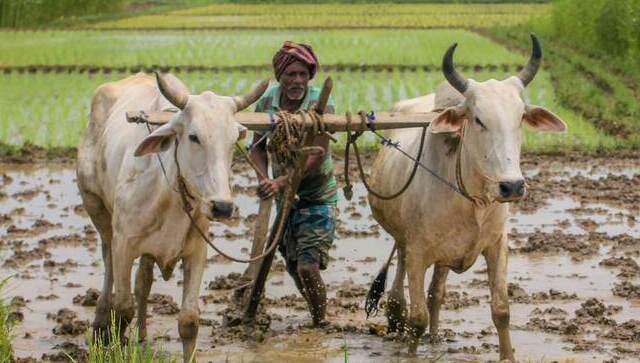Smallholder farmers are important to India’s farming ecosystem. AP
India is an agrarian nation with about 55 per cent of its population dependent on agriculture as their primary source of income. The agriculture sector in India contributed 18.4 per cent to the total GVA of the country for the year 2022-23. It grew at a rate of 3.3 per cent over last year and is projected to grow at a rate of 3.6 per cent in the future. A nation that is so heavily reliant on agriculture needs constant focus of the policymakers. The agriculture ministry was allocated ~2.8 per cent of the union budget 2023-24 along with ~3.8 per cent fertiliser subsidy.
Even though the agriculture industry has changed significantly in the last few decades, farmers are still unable to realise higher prices due to issues like fragmented landholdings, low productivity, limited mechanisation, few opportunities for value addition and a lack of credit availability. Another significant issue is the ineffective extension system, which makes it difficult for modern agricultural practices to reach every farmer and leads to the continued employment of antiquated, basic farming techniques.
The sector requires constant developments to improve productivity, produce quality, levels of mechanisation and automation, levels of processing and value addition, access to information etc. This would be possible by the adoption of cutting-edge-tech in agriculture like artificial intelligence (AI), geographic information systems (GIS), drones, and remote sensing-based technologies along with the development of proper infrastructure for storage and processing of agri commodities (both perishables and non-perishables). These interventions would help India attain self-sufficiency and reach its maximum potential as a global exporter.
Related Articles

AI-news app Artifact, backed by Instagram co-founders, forced to shut shop within 1 year of launch

England’s judiciary welcomes AI into legal system with caution
1. Productivity improvement: Higher levels of productivity will ensure a better per-acre income at the farmer level across the country. Even though India is one of the world’s top producers, its output still trails behind other developed nations. In comparison to India, which produces 2.4 tonnes of rice and 3 tonnes of wheat per hectare, China produces 6.7 tonnes of rice and 5 tonnes of wheat per hectare1. Our scientific community is aware of how productivity levels can be improved, so proper transmission of the know-how at the farmer level should be ensured. This should be aided by adequate fiscal and non-fiscal policy support.
2. Enhancing storage infrastructure: In India, post-harvest losses of around 16 per cent of fruits and vegetables, 10 per cent of oilseeds, 9 per cent of pulses, and 6 per cent of cereals occur every year, mostly as a result of poor storage conditions. Ample steel silos and warehouses should be made available, and they should be outfitted with contemporary sensors to minimize food grain losses and strengthen the system. Along with packhouses, a network of micro-cold storages should be developed to help reduce fruit and vegetable waste on farms and provide farmers with a longer selling window.
3. Driving technology adoption: Agri-tech market size is currently estimated to be over $13 billion, and the agribusiness sector expects a spike in digital usage. Initiatives from the government, such as the National Agriculture Market (e-NAM) Scheme, Digital Agriculture Mission, and Digital Public Agriculture Infrastructure, are designed to encourage Agri-entrepreneurs and promote farmer-centric solutions, hence accelerating the growth of Agri-tech. To increase farmer productivity and profitability, the government should work to promote the use of Agri-tech solutions including drone-based agriculture, IoT-based real-time data collecting systems, and AI-based precision agriculture.
4. Efficient knowledge network: The dissemination of knowledge to farmers needs to be modernized, the agricultural extension machinery of the country needs to leverage smartphone penetration and other digital and physical media to reach out to a maximum number of farmers. The country’s extension system needs to be modernized and in line with evolving technology which will, as a result, allow the ground workers to reach out to more farmers with precise information as well as higher retention by farmers. To affect this transition, the private seed and pesticide firms’ business model can serve as an inspiration.
5. Modernisation of mandis: Efforts have been made to digitalize the agricultural markets at the central level to develop platforms to link sellers and buyers. Many states have also set up e-mandis at state level to improve transparency and smoothen operations. Now the need is to make sure that our farmers and traders can utilise this digital infrastructure and ensure its upkeep. Relevant mandis across the country also need to provide facilities like grading, sorting, drying etc. to help farmers realize better prices for their produce.
Conclusion
It is expected that the agriculture budget for 2024-25 will follow the multi-pronged approach of supporting the sector at various levels. Different challenges that are a pain-point for the farming community like yield improvement, price realisation, information access etc. would be addressed via budget allocation under different subheads. This will foster innovation, enhance productivity, and improve farmers’ livelihoods.
Anand Ramanathan is Partner, Consumer Industry Leader, Consulting, Deloitte India and Mita Chopra is Associate Director, Consulting, Deloitte India. Views expressed in the above piece are personal and solely that of the author. They do not necessarily reflect Firstpost’s views.
Read all the Latest News, Trending News, Cricket News, Bollywood News,
India News and Entertainment News here. Follow us on Facebook, Twitter and Instagram.







